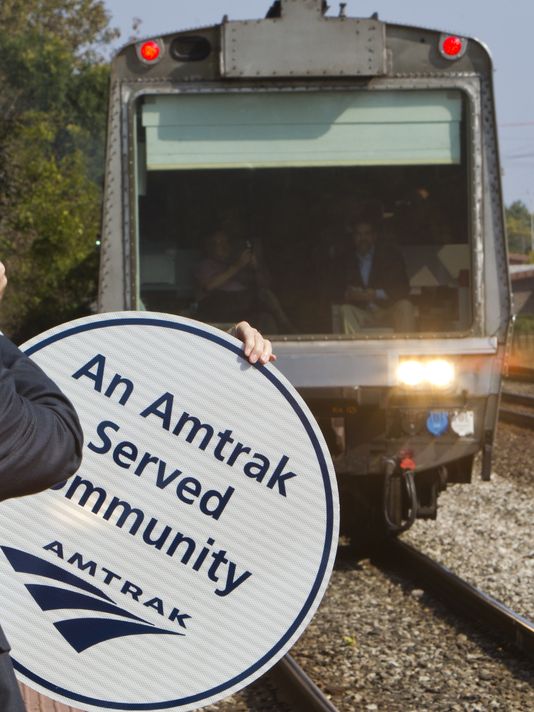From the Lafayette Journal and Courier:

The Hoosier State passenger rail service between Indianapolis and Chicago will run for the last time on April 1, the Indiana Department of Transportation announced March 6, 2015.
The state had been negotiating with Amtrak to continue service after the current contract expires next month. But after more than two years of effort and more than $3 million in state and local tax dollars spent to keep the Amtrak-operated Hoosier State running, the state said it ran into an obstacle it can’t overcome.
The Federal Railroad Administration ruled that Indiana would become a railroad carrier under a new agreement INDOT attempted to negotiate with Amtrak and Iowa Pacific Holdings Inc., a private company that would have marketed the service and provided and maintained rail cars which Amtrak staff would have operated.
As an operator, the state would be responsible for ensuring compliance with federal safety requirements including:
Liability for up to $200 million in each occurrence of injury, death or property damage
Hiring new staff to monitor plans and programs in compliance with federal rules
Making state rail employees subject to retirement and employer liability rules and limits
A redundant layer of bureaucracy and liability expense would only increase taxpayer costs, INDOT commissioner Karl Browning said.
“We’ve done a monumental job of trying to put together a very creative situation where the private sector could help make this a profitable entity,” he said.
But then he added: “The notion of the state becoming a railroad … is insane.”
The state hired attorneys in Washington, D.C. to lobby for a change in the ruling, but the appeals failed to win approval from the Federal Railroad Administration and acting administrator Sarah Feinberg, INDOT attorney Lori Torres said. INDOT posted some of its correspondence online at www.in.gov/indot.
Indiana compared its new rail operating model to the state of North Carolina, which in 2008 successfully fought a similar ruling by the federal rail agency.
The difference is that Indiana hired a third party to provide rail cars, while North Carolina owns the rail equipment, contracts with Amtrak to operate the service and a third party contractor maintains the rail cars, INDOT senior rail planner Venetta Keefe said.
As states take a more active role in managing rail services, they must more closely ensure their services are safe, a Federal Railroad Administration spokesman said.
Browning on Friday sent a letter notifying Anthony Foxx, Secretary of the U.S. Department of Transportation, of the disagreement and that Indiana would give travelers advance notice so they could find alternate transportation.
Communities along the 196-mile route have been fighting to save and improve the often-delayed and inconveniently scheduled four-day-a-week rail service that in October 2013 became the state’s responsibility after Congress ended federal funding for routes shorter than 750 miles.
Arvid Olson, a Greater Lafayette Commerce volunteer, has been leading effort for Greater Lafayette.
“Unless Secretary Foxx personally suspends this ruling, it sounds a death knell for the Hoosier State as well as many growing railroad projects,” he said.
“This doesn’t just affect Indiana. This will effectively kill passenger rail in half a dozen states.”
The agency’s decision will affect other states that support rail lines, INDOT spokesman Will Wingfield said.
The issue never came up last week when elected leaders and members of Greater Lafayette Commerce met in Washington, D.C. with Amtrak CEO and President Joe Boardman, West Lafayette Mayor John Dennis said.
“The spirit was how can we make this work, and how can we make this happen?” he said.
Friday’s announcement felt like a crushing blow.
“The discouraging thing is we’ve worked a long time and we’ve made progress even to the point where there is money in the state budget now to sustain this,” Lafayette Mayor Tony Roswarski said.
But local leaders aren’t ready to give up. The mayors and Tippecanoe County commission president Tom Murtaugh said they understood INDOT’s decision but held some hope things could change by April 1.
“I’m hoping we can apply some pressure,” he said. “We’re going to be making calls to our congressmen and hoping to get FRA to change their determination on this.”
Amtrak offered the state an olive branch. Boardman issued a statement saying America’s railroad is willing to operate the train on a month-to-month basis until an agreement can be reached.
“Amtrak is ready, willing and able to continue to provide safe and reliable service using one of the proven models we’ve used in other states,” he said. It won’t be easy to restore service if it ends, Boardman added.
The state could potentially save the rail line if it could reach an agreement with Amtrak to continue operating it, Torres said.
“We were actually very close (to a contract),” she said.
INDOT has two weeks to decide whether it will file a judicial review in U.S. District Court.
Browning wasn’t tipping his hand.
“We’re not going to do it in the next two weeks,” he said. “We’re not going to close off any options.”
